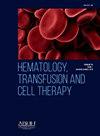COMPARISON BETWEEN MANUAL AND AUTOMATIC SEGMENTATION OF THE WHOLE-BRAIN AND CEREBELLUM
IF 1.8
Q3 HEMATOLOGY
引用次数: 0
Abstract
Introduction/Justification
18F-FDG PET/CT is widely used to quantify brain metabolic activity and plays a key role in studying various diseases. Segmentation method choice can significantly influence standardized uptake value (SUV) measurements, thereby affecting the accuracy of the analysis. The Beth Israel Plugin in ImageJ allows both manual and automatic segmentation, making it relevant for evaluating differences in brain and cerebellum analysis.
Objectives
This study aims to compare the mean, maximum, and peak SUVs obtained through manual and automatic (Grow Mask) segmentation of the brain and cerebellum, assessing the relative percentage differences and variations between the methods.
Materials and Methods
Seventy-three multiple myeloma (MM) patients who underwent 18F-FDG PET/CT were included in the study, comprising 43 men (58.9%) with a mean age of 64.2 ± 11.4 years. Brain segmentation was performed in FIJI using two methods: (1) manual segmentation (MS) consisting of a spherical volume of interest (VOI) of 6.7 mL for the cerebellum and 377 mL for the brain and (2) auto-segmentation (AS) using a Grown Mask algorithm. Manual cropping of PET images was performed before AS to exclude non-cerebellar regions. The relative percentage difference between the two methods was calculated as (1 - MS/AS). Mean, maximum and peak SUVs (SUVmean, SUVmax and SUVpeak, respectively), as well as maximum and minimum variation ranges of SUVs between MS and AS, were recorded.
Results
For the brain, SUVs were higher for AS compared to MS: SUVmean = 4.19 ± 0.02 (MS) vs. 5.99 ± 0.03 (AS), corresponding to 30.05% difference (range: 10.21% to 41.39%); SUVpeak = 8.07 ± 0.05 (MS) vs. 9.05 ± 0.06 (AS), 10.83% difference (range: 0% to 40.59%); and SUVmax = 10.76 ± 0.06 (MS) vs. 11.75 ± 0.07 (AS), 8.43% difference (range: 0% to 55.46%). For the cerebellum, a greater variability between MS and AS SUVs were found: SUVmean = 6.00 ± 0.03 (MS) vs. 5.47 ± 0.02 (AS), corresponding to -9.69% difference (range: 0% to 53.51%); SUVpeak = 7.06 ± 0.03 (MS) vs. 7.29 ± 0.03 (AS), 3.15% difference (range: 0% to 32.96%); SUVmax = 8.23 ± 0.04 (MS) vs. 9.20 ± 0.04 (AS), 10.54% difference (range: 0% to 42.57%).
Conclusion
The choice of segmentation method significantly impacts SUV values. AS yielded higher brain SUVs, while cerebellum MS showed greater variability due to manual adjustments and VOI selection. The differences between methods stem from segmentation techniques: MS used a spherical VOI, sometimes excluding the highest SUV point, whereas AS encompassed the full structure, capturing the true SUVmax. Thus, spherical VOI is less precise for whole-organ analysis but useful for quick regional calculations. Standardizing segmentation methods is crucial for reliable comparisons in clinical and research settings.
全脑和小脑手工分割与自动分割的比较
引言/理由18F-FDG PET/CT 广泛用于量化脑代谢活动,在研究各种疾病中发挥着关键作用。分割方法的选择会极大地影响标准化摄取值(SUV)的测量,从而影响分析的准确性。本研究旨在比较通过手动和自动(Grow Mask)分割大脑和小脑获得的平均、最大和峰值 SUV,评估两种方法之间的相对百分比差异和变化。材料与方法研究纳入了 73 名接受 18F-FDG PET/CT 检查的多发性骨髓瘤(MM)患者,其中 43 名男性(58.9%),平均年龄为 64.2 ± 11.4 岁。在 FIJI 中使用两种方法进行大脑分割:(1) 手动分割 (MS),包括小脑 6.7 mL 和大脑 377 mL 的球形感兴趣体积 (VOI);(2) 使用 Grown Mask 算法进行自动分割 (AS)。在 AS 之前对 PET 图像进行手动裁剪,以排除非小脑区域。两种方法的相对百分比差异计算公式为(1 - MS/AS)。记录SUV的平均值、最大值和峰值(分别为SUVmean、SUVmax和SUVpeak),以及MS和AS之间SUV的最大和最小变化范围。03(AS),相差 30.05%(范围:10.21% 至 41.39%);SUVpeak = 8.07 ± 0.05(MS)vs 9.05 ± 0.06(AS),相差 10.83%(范围:0% 至 40.59%);SUVmax = 10.76 ± 0.06(MS)vs 11.75 ± 0.07(AS),相差 8.43%(范围:0% 至 55.46%)。就小脑而言,MS和AS的SUV值之间的差异更大:SUVmean=6.00±0.03(MS)vs.5.47±0.02(AS),相当于-9.69%的差异(范围:0%至53.51%);SUVpeak=7.06±0.03(MS)vs.7.29±0.03(AS),3.15%的差异(范围:0%至32.96%);SUVmax=8.06±0.03(MS)vs.7.29±0.03(AS),3.15%的差异(范围:0%至32.96%)。结论分割方法的选择对 SUV 值有显著影响。AS 可获得更高的大脑 SUV 值,而小脑 MS 则因手动调整和 VOI 选择而显示出更大的变异性。不同方法之间的差异源于分割技术:MS 使用球形 VOI,有时会将 SUV 最高点排除在外,而 AS 则涵盖了整个结构,捕捉到了真正的 SUV 最大值。因此,球形 VOI 对整个器官分析的精确度较低,但对快速区域计算很有用。要在临床和研究中进行可靠的比较,标准化分割方法至关重要。
本文章由计算机程序翻译,如有差异,请以英文原文为准。
求助全文
约1分钟内获得全文
求助全文
来源期刊

Hematology, Transfusion and Cell Therapy
Multiple-
CiteScore
2.40
自引率
4.80%
发文量
1419
审稿时长
30 weeks
 求助内容:
求助内容: 应助结果提醒方式:
应助结果提醒方式:


